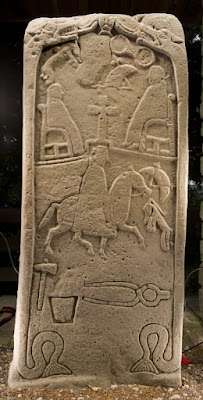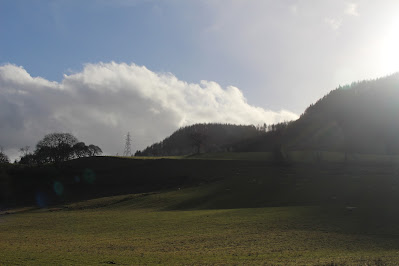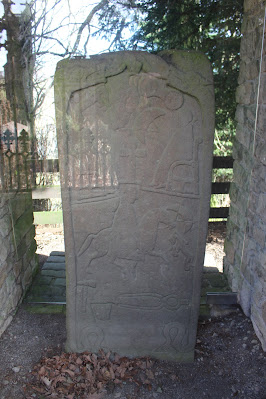Dunfallandy Pictish stone
 |
| The Dunfallandy Pictish stone www.canmore.org.uk |
Just outside of Pitlochry at a place called Dunfallandy, there is a Class II Pictish stone. This is probably one of my favourite Pictish stones. The stone dates to around the 8th/9th centuries. It’s located on a small hill or mound on the west bank of the River Tummel. The mound overlooks some fields towards the west. The stone has been placed in a small shelter to protect it from the weather. On one side of the stone, there’s an ornately carved Christian cross. There are animals, beasts and angels on either side of the cross. On the other side, there are three figures. There are two figures sitting on thrones, probably a man and a woman. Below, there’s a figure on horseback. They’re probably clergy or royalty, or both. Many monks and nuns were actually princes and princesses, who chose the religious life. The Dunfallandy Pictish stone was known as Clach an t-Sagairt, the Priest’s stone in Gaelic. Dunfallandy is located in an area called Fonab, which is derived from the Gaelic for ‘the land of the abbot’. During Pictish times, the land of Fonab was granted to the abbot of Dunkeld. The abbot of Dunkeld was a hereditary position and the abbots were supposedly descended from the kindred of St Columba. St Columba founded the monastery on the Isle of Iona and converted the northern Picts to Christianty.
The figure on horseback may be the abbot of Dunkeld or the king of Atholl or the Pictish kingdom of Fotla, which included Atholl and Gowrie. The abbot of Dunkeld may have also been the king of Atholl. In later times, when Pictland was absorbed into the kingdom of Alba, the abbot of Dunkeld was also the Mormaer of Atholl. The Mormaers were basically Earls. The name Mormaer means ‘Great Steward’ in Gaelic. The two figures sitting on the thrones may be the parents of the abbot or king of Atholl. Next to the three figures, there are Pictish symbols. These may be symbols of identity or status. The horseman has the symbols of the crescent moon and V rod and the Pictish beastie, two of the most prominent Pictish symbols. In previous posts, I have explained that the crescent moon and V rod may be the symbol of the king of Fortriu and the Pictish beastie may be a symbol of royal descent e.g. the symbol of a prince or princess. The father shares the symbol of the crescent moon and V rod and the mother shares the symbol of the Pictish beastie. As such, the stone may be showing the system of matrilineal succession of the Picts. Or at least, showing that the horseman has inherited the two symbols from his father and mother. Below the three figures, there are symbols of metal working tools.
There may have also been an early church on the mound. It may have been a place where the kings of Atholl or Fotla were inaugurated. The people of Atholl would have gathered on the fields below the mound for inaugurations and other important events. To the west of the Dunfallandy stone is Dunfallandy hill which runs to the south all the way to a place called Logierait and the confluence of the rivers Tay and Tummel. At the southern end of Dunfallandy hill, there’s a hillfort which may have belonged to the abbot of Dunkeld. However, the hillfort is probably covered in artificial woodland.
 |
| The Christian cross on the Dunfallandy Pictish stone www.canmore.org.uk |
 |
| The mound at Dunfallandy. |
 |
| Dunfallandy hill. |


Comments
Post a Comment